By Jeffrey A. Rendall; Photos by Jeffrey A. Rendall and Jerry Jutras
WILLIAMSBURG, VA – “I’m a golf architect, not a math major,” said golf architect John LaFoy, after he’d estimated his Kiskiack Golf Club creation was made up of 1 ½ parts – half former trash-dump, half former sand pit and half pristine forest.
LaFoy’s tallying ability may leave something to be desired, but his golf designs make up for a perceived lack of arithmetic acumen. That’s definitely true for his work at Kiskiack, known as one of the Williamsburg area’s best and most playable golf courses. Located about fifteen minutes from the Colonial area, the course is conveniently close to historic attractions, restaurants and hotels. A local favorite as well as a resort course destination, Kiskiack remains highly thought of a decade after its opening in 1997.
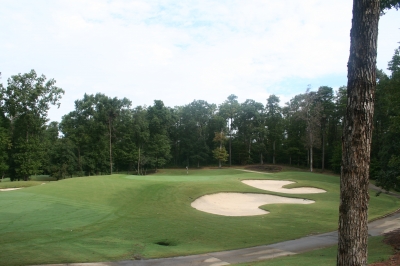 |
| The par five 8th hole. |
LaFoy expands on the beginnings of the project: “I was selected because I’d done two previous successful projects for the owners, Carolina Golf Group, from Raleigh, North Carolina (the course has subsequently been purchased by Traditional Golf Properties). I think I was also selected because of my track record for designing golf courses that came in within a rigid budget and were financial successes in addition to ‘artistic’ successes.”
Ah, the bottom line. It’s easy for us, the golfers, to demand the most from a golf facility – it’d better be in good shape, and it’d better look nice. We shouldn’t pass judgment on owners who demand the same. Luckily, LaFoy was the man to design it that way. Just before Kiskiack was built, LaFoy’s Quarry Oaks (in Ashland, Nebraska) had won Golf Digest’s ‘Best New Affordable Course’ – so he could supply the ‘art’ part of the equation, as well as build on a budget.
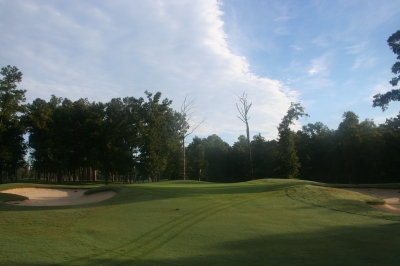 |
| Near the green on the par four 13th hole, you can see the natural beauty that is Kiskiack. |
The property would require someone with skill in working with the land. “I thought the land was beautiful,” LaFoy remembered, but it did offer some obstacles. “A portion of the property had been used as a dump (for construction materials), and another portion was a sand pit to supply sandy fill dirt to building projects. But there was also a lot of the property that was pristine rolling forest. Overall, it was quite nice.”
But the two ‘blips’ on the property presented some tough challenges. The old sand pit had some 15-20’ vertical walls where old fill material had been removed. And because there wasn’t much excess acreage on the deed, the disturbed land had to be incorporated into the overall site plan. LaFoy said building golf holes on that previously used land wasn’t too difficult, but it took some creativity to keep them from looking different from the other holes.
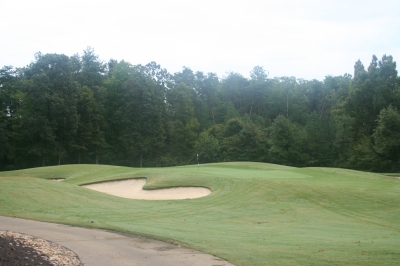 |
| The first of four challenging par threes, the 196 yard 2nd hole. |
The course also needed to be interesting, so LaFoy went to work designing a layout that would offer a test to better players and forgiveness to the resort visitors. “My greens are usually pretty large with lots of pin placements. I have always thought that courses can be made tougher or easier by being able to place the flagsticks in more or less accessible places on the putting surfaces.”
LaFoy continues, “The greens at Kiskiack have a lot of contour, but most of the contours are around the edges where you rarely put a flagstick. There are a few double level greens and at least one false front that is a little unique in the way it was done on the twelfth green. The course isn’t heavily bunkered, but most should have an impact on play.”
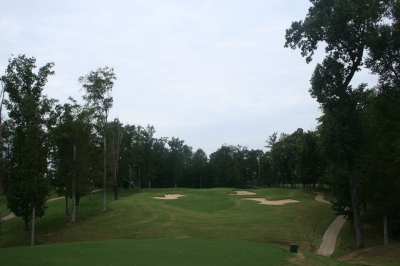 |
| The par three 17th hole plays slightly uphill, which makes it longer than its 181 yards would indicate. |
The course was constructed by Landscapes Unlimited, which has an excellent reputation in the Mid-Atlantic. The bunkers are well built, and the tees and greens complexes seamlessly melt into the landscape.
In addition to the quality of the layout at Kiskiack, one thing you’ll notice… is the absence of houses. With so many of the newer courses being featured as the centerpiece of housing developments, Kiskiack is one of an increasingly rare breed of public access golf clubs that are kept just to themselves. For that reason, there’s very much of a ‘private club’ feeling at the facility.
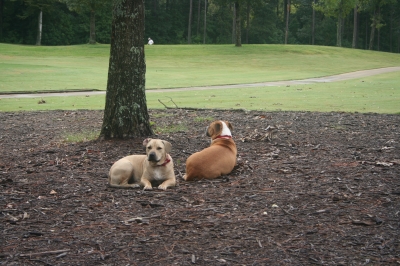 |
| Kiskiack presents a pretty laid-back environment, and even some local dogs feel at home here. |
Kiskiack’s ownership offers memberships, and having talked with several of the local regulars, there was a consensus that Kiskiack was the most forgiving and fun to play of the available courses. It’s also walk-able, which is becoming harder to find. You probably won’t be ‘wowed’ by some of the interior holes, but there’s enough challenge to make you think about shots, and enough room to make sure you won’t lose many golf balls.
LaFoy said he goes out of his way to make sure there aren’t any ‘signature’ holes on all his designs, and Kiskiack is no different. “I feel like successful golf courses have a variety of holes and that everyone seems to have a different favorite hole. It brings a lot of satisfaction for a half dozen players to tell you they each have a different favorite hole. Hopefully that’s what they’ve found at Kiskiack.”
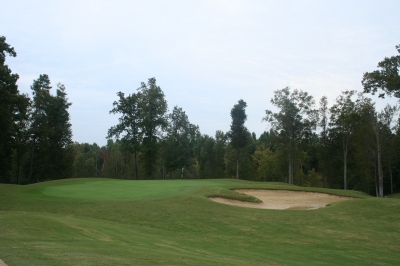 |
| The greens are faily large at Kiskiack, allowing for several pin positions. Here at the par four 16th hole, a large bunker protects against short approaches. |
Because of its setting, most people will probably think the par three 11th hole is the ‘signature’ hole, but that’s only because of all the water and what almost looks like an island green. The holes flow well at Kiskiack, and its variety of settings – ranging from tree-lined to completely open, will leave an impression of variety.
The course stretches to 6775 yards (par 71) and a mid-level slope of 134, so you know it’s more than a walk in the park, but won’t leave you cursing the game of golf at the end of the round.
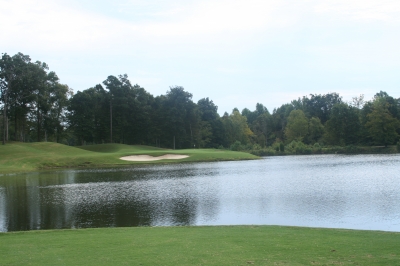 |
| The par three 11th hole. |
Kiskiack’s Head Golf Professional, Brian Tarrant, echoes LaFoy’s earlier comments on the design: “The thing that’s unique about our course is its setting and layout. It’s very player-friendly because it’s pretty wide-open, and many of the fairways gently slope back towards the center, which gives all players a better chance to keep the ball in play. This, along with the tremendous aesthetic beauty of the land makes coming here a great golf experience.”
In other words, even if you’re distracted by the course’s postcard surroundings, its design will help you remember your golf game. Even short hitters have a fighting chance at Kiskiack, and just about everyone will have a good time no matter what their score. There are only three par fours over 400 yards, and none greater than 428 -- and three of the par fives are reachable in two.
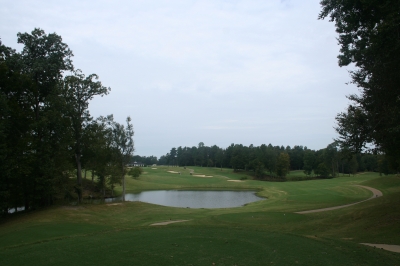 |
| Your options off the 18th tee include, hit to the left, hit to the right, or hit it in the water. |
Tarrant offers his opinion on what makes it challenging: “I think Kiskiack’s difficulty lies in our par threes and around the greens. All our par threes are pretty long -- the shortest from the back tees being number seventeen at 181 yards, but even that’s slightly uphill and often plays into the wind. The others play at 200 yards or more -- so you’ll be hitting long irons or fairway woods into all of the greens.
“You must also -- and this is true for the entire course -- be precise in your approach shots to the greens. The putting surfaces are large and undulating, and provide for many different pin positions. This adds a higher level of challenge because we can tuck the pins in some difficult spots, which will force you to hit good approach shots to get your ball close, or punish you if you miss. It also helps keep the greens in good shape, because worn spots have a chance to recover,” Tarrant said.
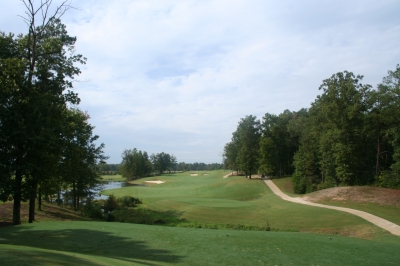 |
| HOLE '9' |
Looking at some of the holes, the course’s player friendly nature is demonstrated by the first hole. At a straightforward 528 yards with a wide fairway, you’ll have a good chance to make your first shot of the round a successful one. Avoid the fairway bunkers that frame the long-range landing area, and you’ve got a decent shot at going at the green in two. There’s a trio of bunkers laying approximately 80 yards before the green, but clearing those allows for a reasonable run-up opportunity. A fairly easy par builds confidence for the round.
The balance of the outward nine winds in and out of parkland and open-space, where you’ll see the true character of the course unfold. There are some mild elevation changes, some generous tee box opportunities, some elevated greens and some incredible scenery. Water comes into play on the eighth and ninth holes -- the left side for both the par five eighth and par four ninth.
The backside’s opening holes bring the largest body of water on the course into play. The tenth is a medium length slight dogleg right with wetlands on the right off the tee and the lake in back of the green. As stated above, the eleventh hole is the club’s ‘signature’ -- a 200 yard par three calling for a full water carry to a three-tiered green guarded by a sizeable set of bunkers in front and to the deep side right.
The round concludes with another great hole. The eighteenth hole probably presents the best view from the tee. The tee box is elevated, and your sight line includes a large pond in front, with landing areas to the right and across the pond. Tarrant says it’s 250 yards of carry to go the short route (from the back tees), but if you can make it, it’ll give you a great chance to go at the green in two.
Summing it up, Kiskiack is just a lot of fun. The course features lush Bermuda grass playing surfaces during the warm months, and reasonable speeds on the greens. This isn’t a course you’re going to see on TV, but if you’re looking for a great golf experience on a layout that’s a local favorite, Kiskiack’s the one.
Or should I say, one and a half.
Details:
The Tradition Golf Club at Kiskiack
| Related Links | Comments on this article? | |
|
Maryland National Golf Club Hollow Creek Golf Club Rocky Gap Resort PB Dye Golf Club in Ijamsville Whiskey Creek Golf Club |
E-mail Jeff Rendall, Editor: jrendall@golftheunitedstates.com |












